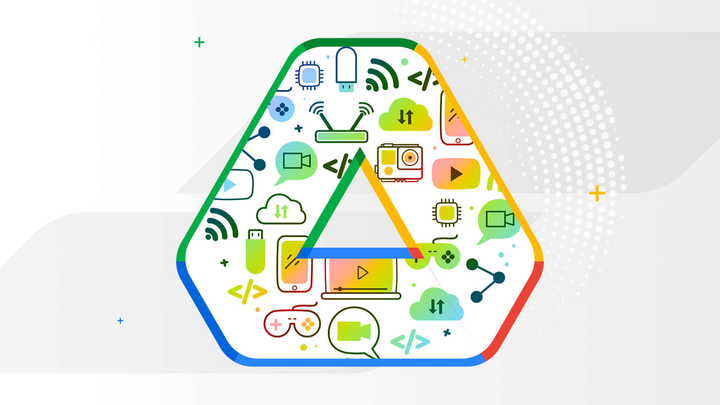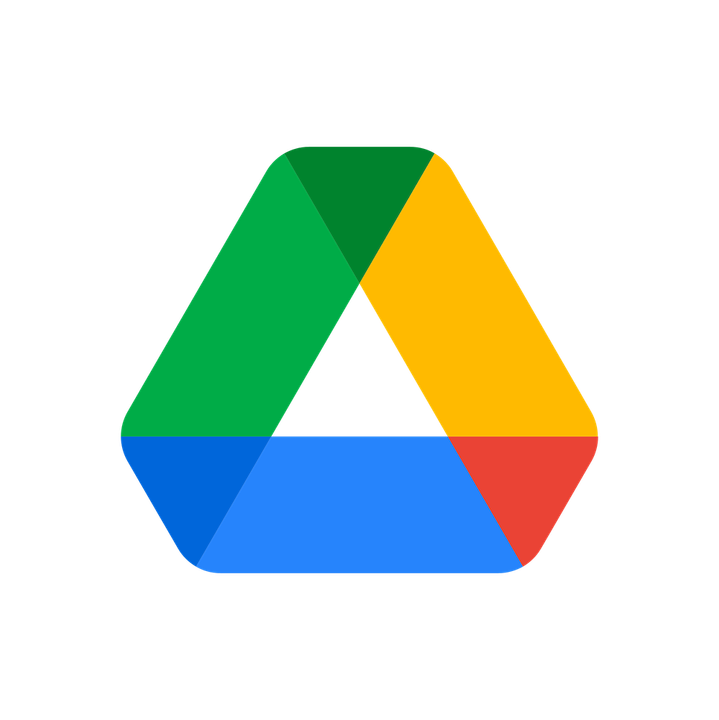



دنبال کنندگان
1
دستهبندی
بهره وری
برچسب
نرم افزار
گوگل درایو یک سرویس ذخیره سازی و همگام سازی فایل است که توسط گوگل توسعه یافته است. گوگل درایو که در ۲۴ آوریل ۲۰۱۲ راه اندازی شد، به کاربران این امکان را می دهد که فایل ها را در فضای ابری (در سرورهای گوگل) ذخیره کنند، فایل ها را بین دستگاه ها همگام سازی کنند و فایل ها را به اشتراک بگذارند. علاوه بر رابط وب، گوگل درایو برنامههایی با قابلیتهای آفلاین برای رایانههای ویندوز و مکاواس و گوشیهای هوشمند و تبلتهای اندروید و آیاواس ارائه میکند. گوگل درایو شامل گوگل داکس، گوگل شیتس و گوگل اسلایدز است که بخشی از مجموعه اداری Google Docs Editors هستند که امکان ویرایش مشترک اسناد، صفحات گسترده، ارائه ها، طراحی ها، فرم ها و موارد دیگر را فراهم می کند. فایلهایی که از طریق مجموعه گوگل داکس ایجاد و ویرایش میشوند در گوگل درایو ذخیره میشوند.
گوگل درایو به کاربران ۱۵ گیگابایت فضای ذخیره سازی رایگان از طریق Google One ارائه میکند. Google One همچنین ۱۰۰ گیگابایت، ۲۰۰ گیگابایت، ۲ ترابایت را ارائه می دهد که از طریق طرح های پولی اختیاری ارائه می شود. حجم فایل های آپلود شده تا ۷۵۰ گیگابایت می باشد. کاربران میتوانند تنظیمات حریم خصوصی را برای فایلها و پوشهها تغییر دهند، از جمله فعال کردن اشتراکگذاری با سایر کاربران یا عمومی کردن محتوا. در وبسایت، کاربران میتوانند یک تصویر را با توصیف تصاویر آن جستجو کنند و از زبان طبیعی برای یافتن فایلهای خاص مانند «صفحه بودجه من از دسامبر گذشته» استفاده کنند.
منبع: ویکیپدیا
Dropbox
برنامه دراپباکس یک سرویس میزبانی فایل است که توسط شرکت آمریکایی دراپباکس، اداره می شود و مقر اصلی آن در سانفرانسیسکو، کالیفرنیا است و فضای ذخیره سازی ابری، همگام سازی فایل ها، ابر شخصی و نرم افزار م
Microsoft OneDrive
برنامه Microsoft OneDrive (قبلاً با نام SkyDrive شناخته می شد) سرویس میزبانی فایل و سرویس همگام سازی است که توسط مایکروسافت به عنوان بخشی از نسخه وب Office خود اداره می شود. OneDrive برای اولین بار در
Microsoft Word
برنامه Microsoft Word یک پردازنده کلمه است که توسط مایکروسافت ساخته شده است. این اولین بار در ۲۵ اکتبر ۱۹۸۳ با نام Word برای سیستم های چند منظوره Xenix منتشر شد. نسخه های بعدی بعداً برای چندین سیستم ع
Google Docs
گوگل داکس (Google Docs) یک پردازشگر واژه است که به عنوان بخشی از یک مجموعه نرمافزاری رایگان و متنی بر وب ارائه شده توسط شرکت گوگل در سرویس گوگل درایو خود است. این سرویس همچنین به ترتیب شامل گوگل شیت
Google Search
گوگل Search یا به سادگی Google، موتور جستجوی وب است که توسط Google LLC ساخته شده است. این موتور با سهم ۹۲.۱۶٪ بازار از دسامبر ۲۰۲۰ و با بیش از ۵.۴ میلیارد جستجو در روز، پرکاربردترین موتور جستجو در شبک
Microsoft To Do
مایکروسافت تودو یک برنامه مدیریت وظیفه مبتنی بر ابر است. تودو به کاربران امکان میدهد از طریق تلفن هوشمند، رایانه لوحی و رایانه کارهای خود را مدیریت کنند. این فناوری توسط تیم Wunderlist تولید شدهاست
Trello
ترلو (Trello) یک برنامه مبتنی بر وب به سبک کانبان و لیست سازی است و توسط Trello Enterprise، یکی از شرکت های تابعه Atlassian توسعه یافته است. در سال 2011 توسط Fog Creek Software (در حال حاضر Glitch) ای
Git
گیت (Git) یک سیستم کنترل نسخه توزیعشده است که وظیفهی مدیریت و ردیابی تغییرات فایلها را بر عهده دارد. این ابزار معمولاً توسط برنامهنویسانی که بهصورت تیمی روی یک پروژهی نرمافزاری کار میکنند، برا
Google Maps
گوگل مپس یک سرویس نقشه برداری وب است که توسط Google ساخته شده است. این برنامه تصاویر ماهواره ای، عکسبرداری هوایی، نقشه های خیابان، ۳۶۰ درجه نمای پانوراما تعاملی خیابان ها (نمای خیابان)، شرایط ترافیکی
Google Chrome
گوگل کروم یک مرورگر وب چند پلتفرمی است که توسط گوگل توسعه یافته است. اولین بار در سال ۲۰۰۸ برای مایکروسافت ویندوز با اجزای نرم افزار رایگان اپل وب کیت و موزیلا فایرفاکس ساخته شد. بعداً به لینوکس ، مک
Google Photos
گوگل فوتوز (Google Photos) سرویس رایگان اشتراک گذاری عکس شرکت گوگل است که از می ۲۰۱۵ به صورت جدا از گوگل پلاس فعالیت خود را شروع کرد.Google Photos به کاربران فضای ذخیرهسازی رایگان و نامحدود عکس با حد
Google Duo
گوگل دوو (Google Duo) یک برنامه چت ویدیویی تلفن همراه است که توسط گوگل توسعه یافته و در سیستم عامل های اندروید و آیاواس موجود است. در کنفرانس توسعه دهندگان گوگل در ۱۸ می ۲۰۱۶ معرفی و انتشار جهانی آن
Google Meet
گوگل میت (که قبلاً به عنوان Hangouts Meet شناخته می شد) یک سرویس ارتباط تصویری است که توسط گوگل توسعه یافته است. این یکی از دو برنامهای است که جایگزین Google Hangouts میشود و دیگری Google Chat است.&
Android Studio
اندروید استودیو (Android Studio) محیط توسعه یکپارچه رسمی (IDE) برای سیستم عامل اندروید گوگل است که بر اساس نرم افزار IntelliJ IDEA JetBrains ساخته شده و به طور خاص برای توسعه اندروید طراحی شده است. ای
Adobe Character Animator
نرم افزار Adobe Character Animator یک محصول نرمافزار کاربردی دسکتاپ برنده جایزه امی است که تصویربرداری زنده را با یک سیستم ضبط چند آهنگ ترکیب میکند تا عروسکهای دو بعدی لایهای را که در فتوشاپ یا ای
Uber
اوبر (Uber) یک سرویس همسفری آنلاین مستقر در سان فرانسیسکو است. اپلیکیشن تلفن هوشمند به طور خودکار، مسافران را با نزدیکترین راننده مرتبط میسازد و موقعیت مسافر را به راننده میفرستد. با بررسیهای انج
Microsoft Excel
نرم افزار Microsoft Excel صفحه گسترده ای است که توسط مایکروسافت برای ویندوز، macOS، اندروید و iOS تهیه شده است. این برنامه شامل محاسبه، ابزارهای نمودار سازی، جداول محوری و یک زبان برنامه نویسی کلان به
Zoom
زوم میتینگز یا بهطور خلاصه، زوم، (Zoom Meetings یا Zoom) یک برنامه نرمافزاری انجام ویدئو کنفرانس از راه دور است که توسط شرکت ارتباطات تصویری زوم، طراحی و توسعه یافتهاست. استفادهٔ رایگان از این برنا
SoundCloud
SoundCloud یک سرویس محبوب برای پخش و اشتراکگذاری موسیقی است که در سال ۲۰۰۷ تأسیس شد. این پلتفرم به هنرمندان مستقل امکان میدهد آهنگهای خود را آپلود کرده و مستقیماً با مخاطبان ارتباط برقرار کنند.&nbs
Microsoft Teams
مایکروسافت تیمز یک پلت فرم ارتباط تجاری اختصاصی است که توسط مایکروسافت به عنوان بخشی از خانواده محصولات Microsoft 365 توسعه یافته است. تیمها در درجه اول با سرویس مشابه Slack رقابت میکنند که چت فضای